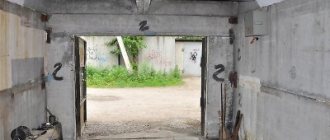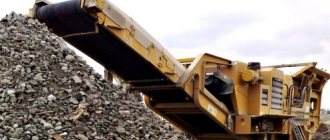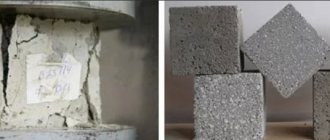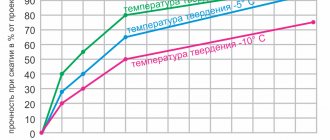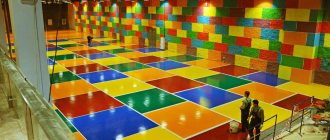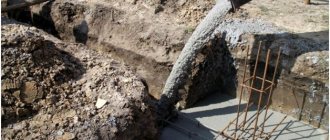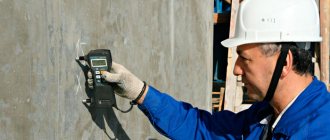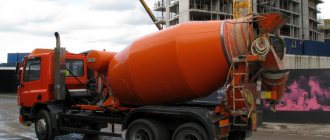| Photo: Kovalev Peter |
Co-owners of the Monolit Group of Companies Alexander Voronov and Igor Konstantinov bought it for 200 million rubles and immediately became the leaders of the concrete market, displacing Andrey Molchanov’s LSR Group.
The leader in the concrete market of St. Petersburg and the Leningrad region, with a capacity of 20 billion rubles per year, has changed. LSR Group, which for many years was the largest manufacturer in the segment with a share of more than 16%, was pushed into the background by a newcomer - Monolit Group of Companies. The other day, the Group of Companies bought two concrete ones.
Sales of LSR in St. Petersburg more than doubled in the first quarter Reporting
Replace concrete with crushed stone
The participants in the transaction themselves told DP that the Monolit Group of Companies bought the concrete ones.
The deal included two concrete plants with a capacity of 100 cubic meters of concrete per hour on Parnassus and a 3-hectare plot below them.
Experts valued the asset at 200 million rubles. “This deal is strategic for us. By closing it, we covered the entire city with our concrete network,” said Igor Konstantinov, general director and co-owner of Monolit Group of Companies. According to him, this year the company intends to invest 40 million rubles in the modernization of the purchased plants, which will increase their capacity by 20%.
“And for us, this deal is part of a program to optimize and reduce the debt burden, which currently amounts to about 300 million rubles,” explained Andrei Sabylin (remember that in 2011, when Lenstroydetal, after the tragic death of the former owner Vladimir Filippov, transferred under the control of Andrei Sabylin and his partners, the company’s debt amounted to 500 million rubles. - Ed.).
The sold plants, according to Andrei Sabylin, accounted for 70% of Lenstroydetal's total concrete production. “So the concrete production business ceases to be the main one for our company. But we are not leaving the market. We have two more concrete nodes in the south of the city, which we will operate ourselves,” he said.
Concrete supplier Taxi-Beton is preparing for bankruptcy Debtors
Monolithic lightweight concrete in high-rise construction
Along with the use of prefabricated lightweight concrete structures in the construction, it is economically feasible to use monolithic concrete.
In our country, monolithic lightweight concrete was first used more than 40 years ago. The main advantages of lightweight monolithic reinforced concrete are the following: 1) the possibility of constructing residential and public buildings of almost unlimited number of storeys;
2) a significant reduction in the lifting capacity of cranes;
3) supply of concrete mixture by concrete pumps; the concrete mixture injection method is especially effective if the construction site is small. Concrete mixture can be supplied to a height of up to 90 m and a length of up to 200 m;
4) saving steel during construction in seismic areas.
The use of monolithic concrete on porous aggregates is especially effective. This is explained by the fact that the low mass and high structural strength of freshly molded lightweight concrete create the most favorable opportunities for organizing work in mobile or adjustable formwork, which is also facilitated by a reduction in the load from the overlying structure.
In foreign construction practice, lightweight concrete is widely used for the construction of monolithic high-rise buildings. Hungarian experts note that the use of lightweight concrete on slag pumice for monolithic walls of residential buildings reduces the cost of construction by 3-7%. In Australia, 50-story buildings made of monolithic lightweight concrete are 15-20% cheaper than conventional ones. The cost of a similar 52-story building in the United States turned out to be equal to the cost of a 32-story building with ordinary reinforced concrete structures. The use of monolithic lightweight concrete compared to heavy concrete becomes significantly advantageous only when the building height is more than 10 floors.
The construction of multi-storey buildings made of monolithic reinforced concrete can be organized in sliding, adjustable sectional or adjustable panel formwork. Specific costs for the manufacture, installation and dismantling of sliding formwork decrease as the height of the building increases, as a result of which the cost of 1 m3 of monolithic lightweight concrete structures also decreases, Research by TsNIIEP housing showed that the construction of buildings in sliding formwork is advisable when their height is at least 9 floors (27 m) and with a simple building configuration with a compact plan. Interfloor ceilings are concreted simultaneously with the construction of walls or separately after finishing concreting the walls to the entire height of the building. The floor structure can be monolithic, prefabricated or prefabricated monolithic.
When working in sliding formwork, the walls must be of the same thickness for the entire height of the building (made of lightweight concrete at least 18-20 cm), and when working in adjustable formwork, the thickness of the walls can be variable. To move the formwork, special hydraulic jacks of the OGD-641 brand are required, operating from an automatic pumping station.
To transport the concrete mixture, tower cranes, elevators and pneumatic transport are used. According to Glavmosstroy, the cost of supplying 1 m3 of mortar or concrete mixture using dense aggregates with a particle size of up to 20 mm is; tower cranes - 1.9 rubles; T-41 lifts - 1.33 rubles; pneumatic superchargers S-862 - 0.62 rubles.
Concrete pumps are divided into piston and pneumatic. The disadvantage of piston pumps is that the rubbing parts quickly fail. A common disadvantage of both piston and pneumatic pumps is their increased energy consumption compared to other means of transporting concrete mixture.
When injecting lightweight concrete mixtures, their mobility quickly decreases as a result of moisture absorption by porous aggregates. Therefore, aggregates must be pre-moistened. Coarse porous aggregate should be moistened so that its moisture content approximately corresponds to water absorption in 24 hours. Small porous aggregate is moistened by mixing with water for 5 minutes directly in a concrete mixer. Then cement, coarse aggregate, and the rest of the water are fed into the concrete mixer and all components are thoroughly mixed.
In order for the concrete mixture to be transported smoothly through pipes, the proportion of fine aggregate in it should be increased compared to the concrete mixture laid in the usual way. The degree of saturation of concrete with coarse aggregate, depending on its maximum size and granulometric composition of sand, is given in Table. 7.4.
To increase the homogeneity and mobility of the pumped concrete mixture, air-entraining additives are used (in an amount that provides an air-entrainment volume of 3-5%) and micro-fillers (thermal power plant ash, ground limestone, etc.).
The experience of constructing high-rise buildings from monolithic lightweight concrete in Minsk and Baku is of interest. In Minsk, a 16-storey single-section residential building was erected in sliding formwork, the external and internal walls of which are made of monolithic agloporite concrete grade 200 with a volumetric mass of 1600 kg/m3. The thickness of the external walls is 45 cm, the internal ones are 20 cm, the ceilings are 16 cm. The individual metal formwork panels are connected to each other by flanges. In addition, they are attached to a metal frame on which hydraulic jacks OGD-644 are installed. Vertical reinforcement is made in the form of spatial and flat reinforcement frames, which are built up as the building is erected. Window and door blocks in external walls are installed in sliding formwork during concreting of the walls. Temporary boxes are placed in the interior walls. Interfloor ceilings - monolithic from aggloporite concrete grade 200 - were erected using the method of floor-by-floor concreting. This grade of concrete was adopted taking into account not only the required strength of the walls of the lower floors, but also the need for accelerated growth of the strength of aggloporite concrete at an early age - concrete should remain in the sliding formwork for no more than 10-12 hours.
When concreting in sliding formwork, the requirements for the early tensile strength of concrete increase, since its value determines the resistance to tearing of the overlying layers of concrete. It has been established that for aggloporite concrete grade 200, the tensile strength at one day of age is 1.5-2.5 kgf/cm2.
The concrete mixture was delivered to the construction site by dump trucks with DSC over a distance of 8 km. The mobility of the concrete mixture was 3-4 od for walls and 1-2 cm for floors. During transportation and laying, the aggloporite concrete mixture did not delaminate. The concrete mixture was supplied to the upper floors by tower cranes. The formwork lifting speed was 12–15 cm per hour.
During the construction of a high-rise 16-story building in Baku, the walls were erected from expanded clay concrete, and the interfloor floors 15 cm thick were made from heavy concrete grade 200. For monolithic steps, expanded clay concrete grade 200 was used with a volumetric mass of 1400 kg/m3. The thickness of the external walls is 28 cm, internal - 18 cm, they were concreted in sliding formwork. The walls were reinforced with vertical, mostly spatial and partly flat, frames. Reinforcement classes AI and A-III, maximum diameter 28 mm. Due to the fact that the city is located in a seismic area, the building structures are made with reinforced reinforcement. To prevent delamination of the concrete mixture during vibration in the formwork, the size of the expanded clay grains did not exceed 20 mm.
Concrete supplier Taxi-Beton is preparing for bankruptcy
3429
Pavel Goroshkov
After the sale, she intends to focus on the production of vibrocompressed products with a capacity of about 500 thousand m2 per year. It will also develop a crushed stone quarry with a capacity of 1.2 million m3 in the village of Lakhdenpokhya, which it bought in 2012, but has not yet developed.
“Prices for crushed stone are rising, but prices for concrete are not. It’s better to engage in a profitable business,” explained Andrey Sabylin. And he added that Lenstroydetal will supply 400 thousand m3 of crushed stone from the new quarry during the year for the needs of the Monolit Group of Companies. “The price will be market price.
The agreement on this supply is one of the terms of the transaction for our concrete Monolith” is a young player in the concrete market. The company was founded in early 2014.
According to SPARK, it belongs on parity to Alexander Voronov and Igor Konstantinov.
The first partner is a non-public figure. There are rumors on the market about his connections with law enforcement agencies, perhaps due to his acquaintance with the management of the Titan security holding company Vladimir Khaschansky. Last year, when Titan entered into a deal to purchase concrete (which never took place), it hired Monolit Group of Companies as an expert to evaluate the assets.
“Alexander Voronov is not a security official and never has been. He owns a package of retail real estate in St. Petersburg, from which he receives a stable income,” said the Monolit Group of Companies. But what kind of stores these are was not explained.
As for Igor Konstantinov, he is a well-known figure in the concrete market. For about 2 years he was the director and co-owner of the Monolit trading house, on the basis of which the Monolit Group of Companies was created. Alexander Voronov invested 150 million rubles in the modernization of the old assets of the Monolit trading house (two concrete plants that came under the control of the new legal entity), as well as in the purchase of new enterprises and in the acquisition of land with access railway tracks to the plants in the north and south of the city.
Currently, the Monolit Group of Companies has four concrete plants with a total capacity of 1 million m3 of concrete per year (13% of the market). After the deal with Lenstroydetal, the company’s share will approach 17%, which will put it in first place in terms of production capacity in the region. According to Igor Konstantinov, Monolit Group of Companies does not intend to stop there.
“We have developed a three-year development plan. Our ambition is 20-25% of the segment,” he says. Also, according to SPARK, this year the owners of the Monolit Group of Companies established Stroitelnaya LLC. But the company has not yet disclosed plans to enter the development market.
Fire retardant coating Monolith
Purpose
Fire retardant composition "Monolit" is a fire retardant thermal insulation coating based on granulated mineral fiber and inorganic binder. Designed to increase the fire resistance of concrete and reinforced concrete structures up to 4 hours.
The fire-retardant plaster composition Monolith type is a sprayed one-component mixture based on targeted additives and a mineral binder (Portland cement). The composition is used to increase the fire resistance of reinforced concrete structures (load-bearing and enclosing walls of buildings and structures, transport tunnels, garages, etc.) up to 4 hours. The “Monolith” composition does not change its appearance, does not crack or peel off from the surface of the structure being protected, withstands minor deformations, impacts and other dynamic loads, and is resistant to mechanical cleaning, aggressive substances and special treatments. The Monolith composition does not contain asbestos and other ingredients harmful to human health and the environment.
Regulatory Requirements
Fire retardant coating “Monolit” for reinforced concrete structures meets the fire safety requirements established in GOST 30247.1-94 “Building structures. Test methods for fire resistance. Load-bearing and enclosing structures." Fire safety certificate No. SSPB.RU.OP047.N.00083. Hygienic certificate 77.01.03.576.P.2024.09.4.
Characteristics
| Color | grey |
| Specific gravity of coating, kg/m3 | 460-550 |
| Theoretical consumption of the composition to obtain a layer 10 mm thick, kg/m2 | 4,5 |
| Compressive strength, MPa, not less | 3,1 |
| Dry density according to GOST 5802-86, kg/m3 | 430 |
| Strength of adhesion to the base without reinforcing mesh, MPa | 0,15 |
| Flammability | Incombustible |
| Operating temperature range under normal conditions, (0C) | -40…+40 |
| Smoke generation | does not contribute to the formation of smoke |
| Fire resistance limit (min) | Layer thickness* (mm) |
| 60 | 10 |
| 90 | 20 |
| 120 | 25 |
| 180 | 35 |
| 240 | 40 |
* For reinforced concrete slabs with a concrete layer thickness to the bottom of the working reinforcement on the heated side of at least 20 mm.
Surface preparation:
Before applying the Monolith composition, dust, dirt, and grease stains must be removed from the surface of the structure to be protected. If necessary, wetting of the concrete surface is allowed.
Application:
Ambient temperature - not less than +30C. Relative air humidity - no more than 85%.
Application methods:
The “Monolith” composition is applied to the protected surfaces using plastering units (“Putzmeister P11”, “ISO-P5”, “T-103”, “MASH-1”, “CAFCO MIX”, “CAFCO JET”, etc.) or manually. In accordance with the Operating Instructions, the dry composition is loaded into the installation and water is added in a ratio of 1:1; Using a pneumatic nozzle, to which compressed air is supplied with a pressure of up to 0.6 mPa and a flow rate of up to 0.5 m3/min, the mortar mixture is applied to the prepared surface. The thickness of the coating layer applied in one pass is no more than 10 mm. When applying a layer with a thickness of more than 8 mm, it is necessary to reinforce the surface to be coated before starting work on the coating. Interlayer drying of the coating at an ambient temperature of at least 200C and relative air humidity of up to 85% takes from 2 to 6 hours. The final drying of the coating to 98% strength must take at least 28 days.
Rinse tools with water immediately after finishing work.
Coating operating conditions:
The coating can be used both indoors and outdoors. Operating temperature: -50…+500С. The service life of the coating is at least 50 years.
Container and storage:
Fire retardant coating “Monolith” is supplied in 30 kg bags. The material must be stored in a dry place in its original packaging. Shelf life: 12 months from the date of manufacture.
